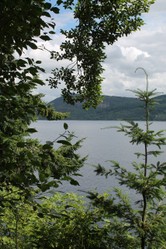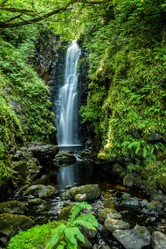The first monster tale comes from the time of St Columba, whose loud voice was said to have scared off a large fish that was attacking one of his monks in the river Ness, that flows from the loch into the North Sea. That was in the sixth century, then there was nothing until the 1930s, when one dark night some motorists spotted a large creature crossing the lochside road. I think that it was likely to be a large red deer stag seen in the interplay of headlights and shadow. But the press got hold of the tory, dubbed the beast "the monster" and thus was a legend born, along with several hoaxes. All pictures of the beast are hoaxes, but some unexplained wakes have been seen.
There have been genuine mistakes. One is caused when a motor boat speeds down the narrow loch and its wake bounces off both sides and the two wakes meet in the middle. A line of waves appears to move down the loch and it is sometimes mistaken for the dorsal fins of a large fish.
But the problem comes with the word monster, which suggests an exotic beast unknown to science. There is something down there, but it is not a monster. There are three possibilities.
a: Sturgeon. This large fish was once common in Scottish lakes. Did a colony of them survive? However, while sea sturgeon have been found in the Moray Firth, which is connected to the loch by the river Ness, none has been caught or sighted in the loch, and no sturgeon DNA has been found.
b: Catfish. Once these fish were released into the loch, but no catfish DNA has been discovered.
c: But eel DNA has been found aplenty in the loch, the species being the European eel. Moreover, with no predators in the loch there is nothing to prevent eels growing large. Large, though not giant, eels are reported in other lakes, such as Loch Morar, which is very close to the sea, and some Irish loughs [lochs.] The monster is just an eel grown large.
Talk of monsters is therefore misleading. Keep the monster story for cartoons.






 The North Wales Pilgrim Pathon 03/30/2024
The North Wales Pilgrim Pathon 03/30/2024
 Rewilding the Isle of the Thundergodon 02/17/2024
Rewilding the Isle of the Thundergodon 02/17/2024
 Adrienne von Speyr a life on the edge of heavenon 01/24/2024
Adrienne von Speyr a life on the edge of heavenon 01/24/2024
 The Granite Kingdom: a Cornish Journeyon 12/29/2023
The Granite Kingdom: a Cornish Journeyon 12/29/2023




Comments
There is No clear distinction between the two types of garden. Planting wise I have never heard of there being a distinction.
The possible consideration of corrib as "stony" causes me to consider rock gardens.
Does it make a difference in its compositional plantings whether or not a garden gets called a rock garden or a stone garden?
Internet searches harvest both phrases, but not enough of the latter term to identify it as different from, or the same as, the former.
I am giving it some thought.
Corrib is a corruption of a Gaelic name for an ancient god to whom the area was sacred.
Frank, you could include the eels and link it into Loch Ness, You must include Oughterade. OOhhh and Ashford Castle.
My Big Bro can do this if anyone can.
It's such a great idea, Veronica! Will you write the article, Frank?
Will I have to wait for the article -- or will you all tell me now -- to learn what corrib -- one internet source says "cultivated variety of potato" and another "stony"! --means?
I would need to do some research, but it is a good idea.
Having seen a super large eel in Lough Corrib, I can easily see how it could be taken for a monster! I do think Frank, that an article about Lough Corrib and the eels , geology, mythology , history would be fantastic.
St Columba's voice was said to have scared the monster away on one occasion, but why nothing was reported for 1400 years is open to discussion. But tradition has it that Columba had a remarkably loud preaching voice.
Has there been any explanation for why St Columba's loud voice managed to scare the monster away for 1,400 years (quite a feat), not forever?
Is there any reason -- such as environmental disruption or large-scale development -- for why the monster would show up in the 1930s?